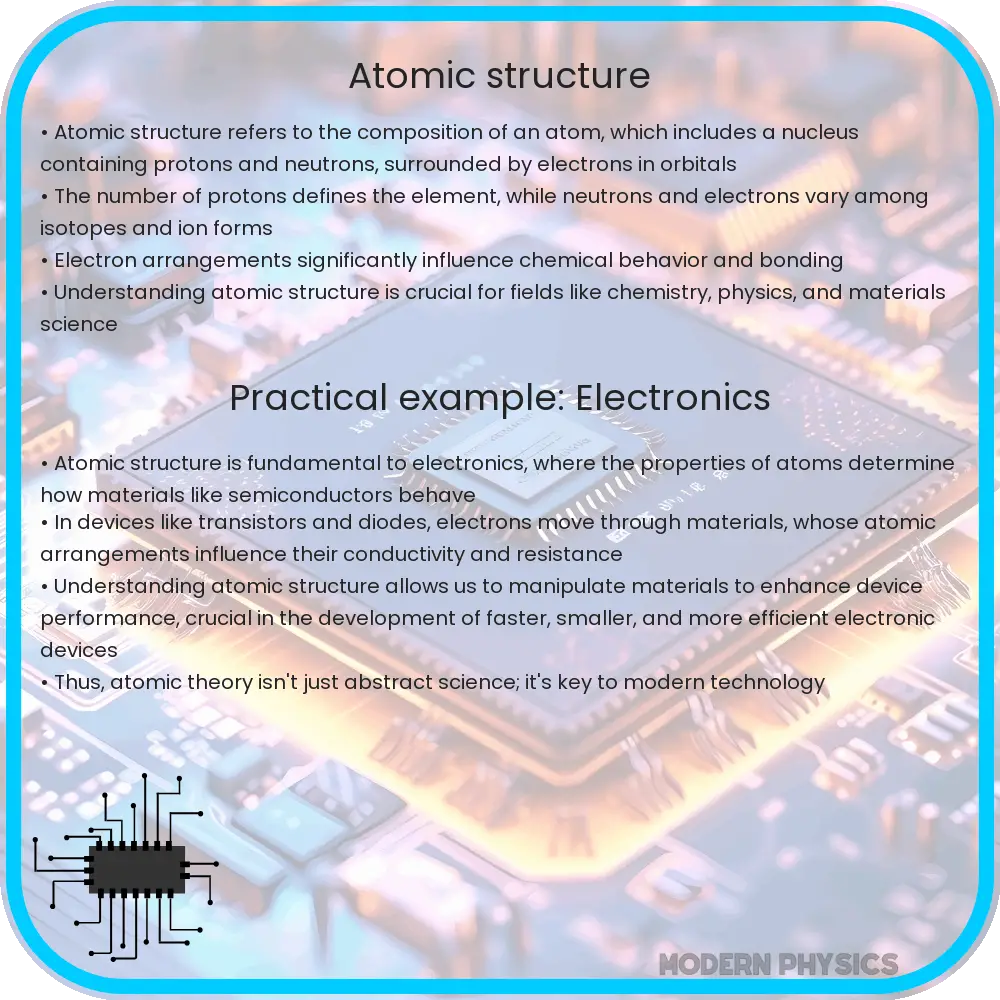Learn about atomic structure, the fundamental concept in physics explaining the composition and behavior of matter, and its impact on technology and science.

Understanding the Atomic Structure: Basics and Its Significance
The world around us is composed of matter, and the fundamental building block of all matter is the atom. Atomic structure is a key concept in physics that explains the composition and behavior of everything in the universe, from the tiniest particles to massive celestial bodies. By understanding atomic structure, we not only gain insight into the nature of matter but also pave the way for advancements in technology, medicine, and materials science.
The Components of an Atom
Atoms are made up of three primary particles: protons, neutrons, and electrons. Each of these particles plays a significant role in determining the properties and behaviors of an atom.
- Protons – These are positively charged particles found in the nucleus, the central part of the atom. The number of protons in the nucleus determines the atomic number, which is elemental in defining the type of element an atom represents.
- Neutrons – Neutrons are neutrally charged particles, also located in the nucleus alongside protons. The number of neutrons can vary in the same element, resulting in different isotopes of that element.
- Electrons – These are negatively charged particles that orbit the nucleus in various energy levels or shells. The arrangement of electrons affects an atom’s chemical properties and its ability to bond with other atoms.
Atomic Models: From Dalton to Quantum Mechanics
Our understanding of atomic structure has evolved significantly since the early 19th century. Below are key milestones in the development of atomic theory:
- Dalton’s Atomic Theory (1803) – John Dalton proposed that all matter is made of tiny indestructible units called atoms. However, his model assumed that atoms were solid spheres, a notion that was corrected by later discoveries.
- Thomson’s Plum Pudding Model (1897) – J.J. Thomson discovered the electron, which led him to propose that atoms were composed of positively charged ‘pudding’ with negatively charged ‘plums’ (electrons) embedded within it.
- Rutherford’s Nuclear Model (1911) – Ernest Rutherford’s gold foil experiment revealed that an atom has a small, dense nucleus surrounded by orbiting electrons. This model laid the groundwork for understanding atomic structure more accurately.
- Bohr’s Model (1913) – Niels Bohr developed a model where electrons travel in specific orbits around the nucleus. Each orbit represents a different energy level. This model introduced quantum mechanics into atomic theory.
- Quantum Mechanical Model of the Atom (1926) – Erwin Schrödinger and Werner Heisenberg formulated the quantum mechanics theory, which describes electron orbits as probabilistic clouds rather than defined paths. This model is the most accurate depiction of atomic structure to date.
This progressive understanding shows how our view of the atom has changed from a simple indivisible particle to a complex system governed by the principles of quantum mechanics.
Significance of Atomic Structure in Modern Science and Technology
The study of atomic structure is crucial for multiple fields. In chemistry and materials science, it helps in the development of new materials with specific properties by manipulating the atomic arrangement. In medicine, understanding atomic interactions leads to better pharmaceuticals and innovative treatments like radiotherapy.
In technology, semiconductors rely on precise knowledge of atomic structure to optimize their properties for use in electronics. Additionally, nuclear physics, which is predicated on knowledge of the nucleus, has led to the development of nuclear power and medical diagnostic techniques such as MRI and CT scans.
Challenges and Future Directions in Atomic Research
Despite the advancements in atomic theory, scientists continue to face challenges that push the boundaries of current understanding. One major challenge is the reconciliation of quantum mechanics with general relativity, aiming to explain phenomena on both the subatomic and cosmic scales. This pursuit has led to the development of theories such as string theory and quantum gravity.
Furthermore, as we delve deeper into the atomic world, the manipulation and control of individual atoms have become a key area of research. This includes the study of quantum computing, where atoms and subatomic particles are used to perform complex computations far more efficiently than traditional computers.
- High-Energy Physics and Collider Experiments: Scientists use particle accelerators to smash atoms together at high speeds, creating conditions similar to those just after the Big Bang. These experiments help in discovering unknown particles and testing the predictions of theoretical physics.
- Nanotechnology: Manipulating matter at the atomic and molecular scale has significant implications for engineering, with the potential to create materials that are stronger, lighter, and more reactive than anything currently available.
Conclusion
The journey from the initial solid-sphere model of an atom to the complex quantum mechanical model shows the remarkable progress of science in understanding the building blocks of nature. Each model has built upon the discoveries of its predecessors, showcasing the evolving nature of scientific knowledge.
Today, the significance of atomic structure extends beyond theoretical physics, influencing practical applications in every domain from material science to pharmaceuticals and beyond. As we continue to unravel the mysteries at the subatomic level, the potential for new technologies and solutions for global challenges appears limitless. With continued research and innovation, the fundamental understanding of atomic structure will likely lead to breakthroughs we can barely imagine today.
Ultimately, the study of atoms is not just about understanding the matter itself, but also about applying this knowledge to improve the human condition, harnessing the laws of nature to foster development and well-being across various aspects of life.
